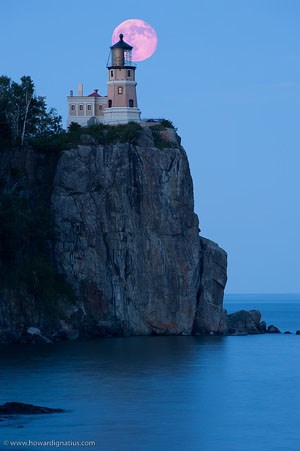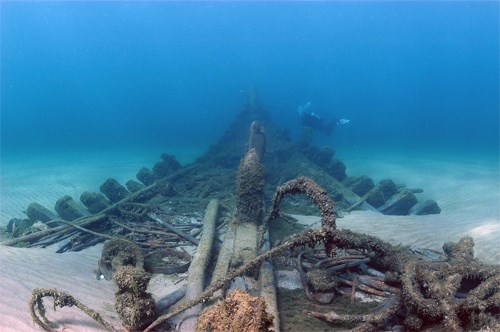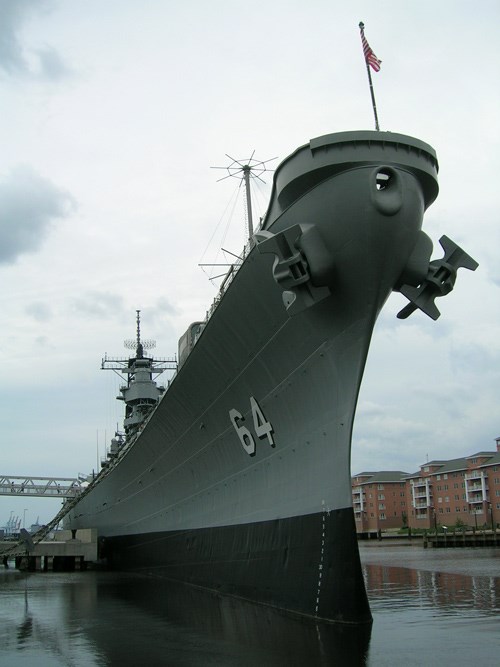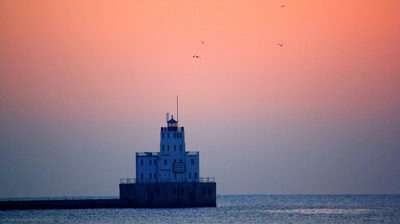The National Register of Historic Places is pleased to promote awareness of and appreciation for historic aids to navigation and their role in maritime heritage.

Photograph by HowardIgnatius on Flickr
Introduction:
The National Register of Historic Places brings you a feature on the significance of lighthouses, and other aids to navigation, in American history, maritime history, architecture, and historic preservation. Since the invention of sailing and maritime vessels in ancient times, aids to navigation consistently played a role in human history. Due to amazing technological advances in navigation, imaging, and geographic positioning, the importance and domination of lighthouses as aids to navigation has quickly diminished over the past 100 years. Now these beautifully built lighthouses and light stations are merely markers of a more precarious time in maritime history – no longer functioning or active, we look to them to study architecture, industry, commerce, travel, scientific advancement, and the people and towns affected by what lighthouses guided into harbor.
"The lighthouse is the most romantic symbol of the maritime past. Marking dangerous headlands, shoals, bars, and reefs, lighthouses have guided vessels safely on their voyages since antiquity. Often placed in rugged, remote locales, in shifting sand, on coral reefs, and on surf-washed rocks lighthouses posed many engineering challenges in their construction. The technology of the light itself also presented a challenge; the importance of a constantly lit signal, visible for miles out to sea, attracted the attention of many inventors.
"Lighthouses, daymarks, sound signals, and buoys all serve as aids to navigation. The earliest aid to navigation was probably a prominent natural landmark, but landmarks could be confused with one another so distinctive man-made markers called beacons were erected along the coastline to help warn off or guide mariners. Beacons were useful only during daylight hours. Light signals guided ships at night. Begun as bonfires on shore, they increased in complexity and effectiveness to become towers built high above the surf. The need for aids to navigation boomed as maritime trade and commerce flourished. In the 17th, 18th, and early 19th centuries the number of lighthouses rapidly increased.
"During the 17th and 18th centuries, numerous aids to navigation in North America included daybeacons, lanterns placed atop poles, and signal guns fired to guide ships into harbor. The first built lighthouse in the present United States was erected in 1715-1716 with the construction of the Boston Light on tiny Beacon (now Little Brewster) Island. First lit on September 14, 1716, the Boston Light's "feeble flame," noted historian F. Ross Holland, "gradually grew brighter, and in time illuminated all the shores of the United States." Nine other Colonial lights were built in the 1740s through the 1760s. With the establishment of the United States of America, as its ninth act after adopting the Constitution and the Bill of Rights, Congress assumed federal responsibility for the construction and operation of aids to navigation. This act, passed on August 7, 1789, inaugurated more than 200 years of federal commitment to safe navigation. Since the Lighthouse Act of 1789, more than 1,000 lighthouses have been built along with hundreds of fog signals and nearly 200 lightships.
"Lighthouses and sound signals are now passing from the American scene. Technological changes in the 20th century ultimately doomed manned lighthouses; the last keeper left his station in 1989, the Bicentennial year of America's lighthouses. Some lighthouses now stand dark, while others now automated still function. Many lights are in non-federal hands. The Coast Guard has control over some 500 active lights. Other federal agencies are responsible for approximately 150 inactive light stations. The ravages of time and weather strongly affect aids to navigation which were intentionally built in exposed locations. The harsh marine environment washes away foundations, dissolves mortar, crumbles stone and brick, and corrodes metal. Lighthouses are a finite resource in danger of being lost."
-From NR Bulletin 34: Aids to Navigation

Photograph courtesy of Wisconsin State Historic Preservation Office
Featured Properties:
Great Lakes Shipwreck Sites of Wisconsin Multiple Property SubmissionSilver Lake (scow-schooner) Shipwreck - Wisconsin, Lake Michigan
The Silver Lake had a relatively short 11- year career working in the Lake Michigan lumber trade. Constructed in 1889 by M. L. Johnson shipyard at Little Point Sable, Michigan, the Silver Lake sank in a collision with the Pere Marquette car ferry in a dense fog in 1900.
Australasia Shipwreck (Wooden Bulk Carrier) - Wisconsin, Lake Michigan
Built in 1884 by the well-known shipbuilder Captain James Davidson in West Bay City, Michigan, the 285-foot long Australasia was the largest wooden vessel ever built at the time of her launch. During her twelve year career, the Australasia carried bulk cargoes across the Great Lakes so efficiently she earned a fortune for her owners at a time when wooden vessels were quickly becoming obsolete.
America Shipwreck (Canaller) - Wisconsin, Lake Michigan
Constructed in 1873 and lost in 1880, the America represents a vessel class, the canaller, which traveled the longest routes of any of the Great Lakes vessels while carrying Midwestern grain to eastern markets.
EMBA Shipwreck (Self-Unloading Barge) - Wisconsin, Lake Michigan
Built in 1890 at the Frank W. Wheeler & Company shipyard in West Bay City, Michigan, the 181-foot long EMBA was launched as the schooner barge A. C. Tux bury. During her first thirty-three years the A. C. Tux bury, and her sistership the C. E. Redfern, carried bulk cargoes across the Great Lakes as consorts to the steamer W.H Sawyer.
Ocean City , NJ Life-Saving Station - Ocean City, New Jersy
his station was one of forty-five stations established on the New Jersey coast, and two hundred and ninety-two in the United States before the modern Coast Guard was formed in 1915, and is one of fifteen in the state that still survive from this period.
e state that still survive from this period.

Photograph courtesy of Virginia State Historic Preservation Office
Motor Torpedo Boat PT-658 is historically significant for its association with the Pacific War against Japan during WW II and as an example of the Navy's combat doctrine that incorporated the use of inexpensive, fast, versatile, heavily-armed, and lightly-protected boats to support a variety of combat missions, including harassing enemy shipping, rescuing downed pilots, assisting in shore landings, and attacking larger more heavily-armed and -armored ships.
USS Wisconsin, Norfolk, Virginia
Authorized by Congress on July 6, 1939 and launched on December 7, 1943, the Wisconsin is one of four completed Iowa-class fast battleships, among the last built by the United States Navy. The Wisconsin received her first commission on April 16, 1944, when the ship embarked on several months of sea trials before joining combat forces in the Pacific as part of Admiral William F. “Bull” Halsey’s Third Fleet. (Previously highlighted in our summer feature)
Boca Grande Lighthouse at Gasparilla Island, Florida
Located at the southern tip of Gasparilla Island in Lee County, Florida, the Boca Grande Lighthouse played a significant role in the opening of the Boca Grande Harbor for large phosphate shipments beginning in late 1890. The lighthouse's design reflects its use as a harbor beacon which did not require significant elevation, as opposed to beacons used for alerting outer maritime traffic.
Portland Headlight, Maine
The Portland Headlight sits high on a rocky promontory jutting into Casco Bay near Cape Elizabeth, Maine, which was used as a lookout post during the American Revolution. Soldiers on guard at Portland Head could see approaching British ships and warn the citizens of an imminent attack. President George Washington authorized the construction of this and three other lighthouses, and the main section of the tower remains much as it was when completed in 1790. Constructed by two local masons using stone from the nearby fields and shore, it originally stood seventy-two feet high, with a fifteen foot lantern. In 1813 and again in 1883, the tower's height was reduced by about 20 feet, but it was raised again with brickwork in 1885, then repaired in 1900 using the original stones. The Portland Headlight has stood as a beacon of U.S. commerce for well over two centuries and remains a significant part of Maine's history, as perhaps the best-known and most photographed lighthouse on the northeast coast. The Portland Headlight is now owned and managed by the Town of Cape Elizabeth, Maine.
Boston Light, Massachusettes
Boston Light marks a main shipping entrance to Boston Harbor—New England's busiest port—which has been commercially active since the 17th century. Established in 1716, the original stone tower was the first lighthouse built in North America. The British destroyed Boston Light during the Revolutionary War in 1776. Rebuilt in 1783, the present light tower is recognized as the Nation's second oldest. Other separate station buildings still standing on the site are the 1876 fog signal building, 1884 keeper's dwelling, 1884 cistern building, 1889 oil house and 1889 boathouse. The buildings are clustered on the three-acre island and connected by foot paths. Boston Harbor Light Station was designated a National Historic Landmark in January 1964. Preservation groups appealed to Congress and the U.S. Coast Guard, and funding was appropriated to keep U.S. Coast Guard staff at the light station, thereby making it the last manned light in the Nation. It is still an active aid to navigation.
Plum Island Life-Saving and Light Stations, Wisconsin
Built in 1896, the Plum Island Life-Saving and Light Stations helped ships navigate the Porte des Morte (Death's Door) passage, a treacherous passage named for the high number of shipwrecks that occurred on its rocky shoals. The Life-Saving and Light Stations assisted Lake Michigan's mariners until well into the twentieth century, supporting the safe and expedient passage of goods and people and playing a significant role in the transportation, commerce, and maritime history of the State of Wisconsin. The Stations are currently owned by the Fish and Wildlife Service which has partnered with the non-profit Friends of Plum and Pilot Islands to preserve and manage the island's historic and cultural resources.
Split Rock, Minnesota
The Split Rock Lighthouse was constructed in the summer of 1909 on a scenic point along the west end of Lake Superior in Lake County, Minnesota. After more than fifty years of petitioning, and a late November gale in 1905 which damaged twenty-nine ships on the lake, the Minnesota legislature finally convinced Congress in 1907 to authorize construction of the much-needed beacon. The cargoes of high-grade iron ore and the iron deposits in the lake basin itself caused compass needles to stray from true north, causing many a ship to run aground in the shallows of the rocky coast. Construction was difficult since there were no roads, making it necessary to bring all the workmen and materials across the lake, and then up a 124-foot cliff.
Lightship WAL-604, COLUMBIA, Oregon
Lightship WAL-604, known as the Columbia, was built in 1950 by the U.S. Coast Guard in the characteristic design of 20th-century lightships, with some improved features such as an all-welded hull, transverse bulkheads, modern interior accommodations, and an alternating current electrical system. The ship was in service along the Columbia River Bar off the coast of Oregon. The combination of sturdy exterior and comfortable interior meant that this lightship could stay out in the roughest seas with as many as 19 crew members and officers. As with other lightships, the Columbia has two pole masts each topped by a light visible up to thirteen miles away, a fog signal that could be heard up to five miles away, a radio beacon synchronized with the fog signal, and a simple hand-operated bell. The ship was decommissioned in 1979, having been the last lightship in service on the Pacific Coast. Only twenty-two American lightships remain, and only six of those remaining were built by the U.S. Coast Guard. The Columbia is one of the best-preserved lightships remaining, and following decommission the lightship was opened as a maritime history museum on the Astoria, Oregon waterfront, while retaining the appearance of an active duty vessel.

Photograph by IndyKethdy2 from Flickr
Port Austin Light, Michigan
Port Austin Light in Lake Huron was built in 1878. It is owned by the U.S. Coast Guard. It sits in approximately six feet of water and marks a hazardous rocky reef on the south side of Saginaw Bay near the turning point for vessels entering or departing the bay. The light house is 90 feet tall and includes an octagonal wooden crib foundation, octagonal pier with boat landing, brick masonry superstructure. It signals a white flash every six seconds and is visible for eight miles in clear weather.Milwaukee Breakwater Light, Wisconsin
stands in Lake Michigan’s Milwaukee Harbor. It was built in 1927 by the U.S. Coast Guard. It embodies twentieth century lighthouse architecture and engineering. Also the methods to construct the crib foundation and steel tower are typical of the time period. The Milwaukee Breakwater Light was Art Deco styling and design expresses its modernity and verticality.
Fowey Rocks Light and American Shoal Light are listed in the National Register of Historic Places because they represent US Aids to Navigation. They embody late nineteenth century lighthouse architecture and engineering. Both exemplify design and construction methods characteristic of offshore skeletal tower lighthouses during that time period, and retain integrity in terms of location, setting, design, materials, workmanship, feeling and association.
Last updated: September 25, 2019
